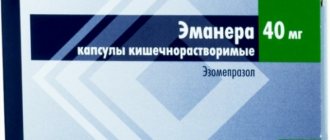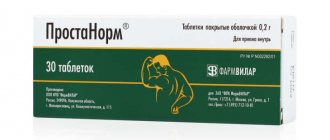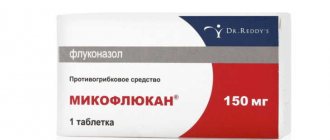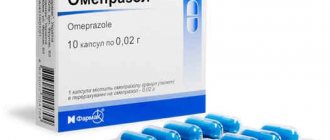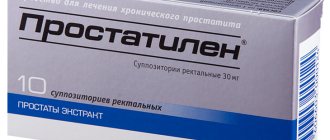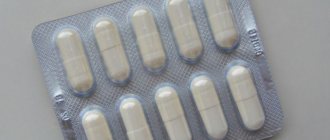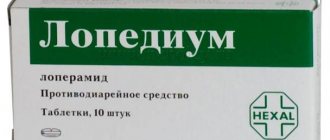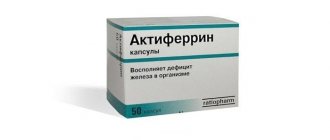The drug is a penicillin antibiotic together with an inhibitor of microbial enzymes. Thanks to the combination, the spectrum of action of the drug extends to resistant bacteria.
Has a bactericidal effect on:
- Staphylococcus
- Streptococci
- Haemophilus influenzae
- Meningokokkiro
- Gonococci
- E. coli
- Klebisiella
- Bacteroides
- Haemophilus parainfluenzae
- Citrobacter spp.
- Clostridium spp.
- Peptococcus spp.
- Peptostreptococcus spp.
- Enterobacter spp.
- Proteus spp.
Release form and composition
The drug is produced in the form of a powder for the preparation of a solution for intravenous (IV) and intramuscular (IM) administration: white or white with a yellowish tint. The drug in dosages of 250 mg + 125 mg, 500 mg + 250 mg, 1000 mg + 500 mg or 2000 mg + 1000 mg is packaged in transparent glass bottles of 10 and 20 ml, which are sealed with bromobutyl rubber stoppers and rolled with an aluminum ring with a snap-off plastic lid. A cardboard box contains 1 bottle of the drug, instructions for use of Ampicillin + Sulbactam and 1 ampoule with solvent* (or without ampoules with solvent) in a volume of 1 ml - for a dosage of 250 mg + 125 mg; 1.8 ml – for a dosage of 500 mg + 250 mg; 3.5 ml – for a dosage of 1000 mg + 500 mg; 10 ml – for a dosage of 2000 mg + 1000 mg. For hospitals, 5, 10 and 100 bottles of the drug and the corresponding number of ampoules with solvent (or without ampoules with solvent) are packed in a cardboard box.
* Solvent - water for injection (in ampoules made of neutral colorless glass or low-density polyethylene).
Composition of active substances in 1 bottle:
- dosage 250 mg + 125 mg: ampicillin (in sodium form) - 250 mg, sulbactam (in sodium form) - 125 mg;
- dosage 500 mg + 250 mg: ampicillin (in sodium form) - 500 mg, sulbactam (in sodium form) - 250 mg;
- dosage 1000 mg + 500 mg: ampicillin (sodium form) – 1000 mg, sulbactam (sodium form) – 500 mg;
- dosage 2000 mg + 1000 mg: ampicillin (sodium form) - 2000 mg, sulbactam (sodium form) - 1000 mg.
Preparations containing (Sulbactam analogues)
The trade name of cefoperazone + Sulbactam is Bakperazone. There are also structural analogues of cefoperazone + Sulbactam: Pactocef , Sulmagraf , Sulperazon Sulcef , Cefbactam , Cefpar SV , Sulzoncef , Sulmover , Sulperacef , Cebanex .
Analogues of ampicillin + Sulbactam: Sultasin , Ampisid , Libaccil , Unazin . The dosage form of ampicillin + Sulbactam tablets is not available in pharmacies.
The combination of amoxicillin + Sulbactam is found in the drug Trifamox IBL . The combination of ceftriaxone + Sulbactam can be purchased under the trade name: Broadcef-S .
Pharmacological properties
Pharmacodynamics
Ampicillin + Sulbactam is a combined drug that has a bactericidal effect against ampicillin-sensitive bacteria, including beta-lactamase-producing strains.
Ampicillin is a semi-synthetic penicillin with a wide spectrum of activity. The mechanism of action is due to the ability of the substance to inhibit the synthesis of cell wall proteins of pathogenic bacteria.
Sulbactam is an irreversible beta-lactamase inhibitor. When combined with ampicillin, it expands the spectrum of its activity against resistant strains, the resistance of which is formed under the influence of beta-lactamases. Does not change the effect of ampicillin against sensitive strains. Binds to some penicillin-binding proteins of bacteria, and therefore exhibits synergism when used in combination with beta-lactam antibiotics. Stable in aqueous solution. Shows independent antibacterial activity against the Acinetobacter spp. family. and Neisseriaceae. Resistant to the action of most plasmid beta-lactamases.
The following microorganisms (including beta-lactamase-producing strains) are sensitive to the combination drug Ampicillin + Sulbactam:
- anaerobic bacteria: Bacteroides spp. (including B. Fragilis), Clostridium spp. (except Clostridium difficile), Peptostreptococcus spp., Peptococcus spp.;
- aerobic gram-negative bacteria: Klebsiella spp., Escherichia coli, Providencia stuartii, Providencia rettgeri, Haemophilus influenzae (including ampicillin-resistant strains), Proteus vulgaris, Proteus mirabilis, Morganella morganii, Moraxella catarrhalis (including beta-lactamase-producing strains), Neisseria gonorrhoeae (including beta-lactamase producing strains);
- aerobic gram-positive bacteria: Enterococcus faecalis, Listeria monocytogenes, Streptococcus pyogenes, Streptococcus spp. viridans group, Streptococcus pneumoniae (including penicillin-resistant strains), Staphylococcus saprophyticus (including beta-lactamase-producing strains), Staphylococcus aureus (including beta-lactamase-producing strains), Staphylococcus epidermidis (including beta-lactamase-producing strains), lactamase).
Methicillin-resistant Staphylococcus spp., Chlamydia pneumoniae, Citrobacter spp., Clostridium difficile, most strains of Enterobacter spp., Mycoplasma pneumonia, Mycobacterium spp., Pseudomonas aeruginosa are resistant to the drug.
Pharmacokinetics
After intravenous (i.v.) administration of the drug in doses of 1500 and 3000 mg, the maximum serum concentrations (Cmax) are respectively: for ampicillin - 40-71 and 109-150 mcg/ml, for sulbactam - 21-40 and 48-88 mcg/ml ml.
After intramuscular (IM) administration of 1500 mg of the drug, Cmax of ampicillin varies within the range of 8–37 μg/ml, Cmax of sulbactam – 6–24 μg/ml.
Bonding with plasma proteins: ampicillin – 28%, sulbactam – 38%. Both medicinal substances are well distributed in various body fluids and tissues.
After IV and IM administration of Ampicillin + Sulbactam, therapeutic concentrations are created in the skin and subcutaneous tissue, pelvic organs, intestinal wall, interstitial and pleural fluids, and peritoneal fluid.
Both drugs penetrate the blood-brain barrier poorly, but with inflammation of the meninges, permeability into the cerebrospinal fluid increases.
The half-life (T½) of ampicillin and sulbactam averages approximately 1 hour. Both substances are excreted primarily by the kidneys unchanged. About 75–85% of the administered dose is excreted during the first 8 hours after administration of the drug. In patients with impaired renal function, T½ increases, so adjustment of the dosage regimen is required.
Pharmacodynamics and pharmacokinetics
The mechanism of action of the substance is based on the inhibition of chromosomal beta-lactamases by acetylation and hydrolysis of the complex formed with them, which leads to the death of the bacterial cell. The product is active against Acinetobacter spp., Neisseria gonorrhoeae, Bacteroides, Klebsiella рneumoniae, Neisseria gonorrhoeae, Bacteroides fragilis, Staphylococcus aureus, Haemophilus influenzae, Moraxella catarrhalis, Escherichia coli. This antibacterial agent has a higher degree of resistance to changes in the pH of the solution, which ensures its high efficiency. The product is used for infectious processes with changes in the acidity of the environment.
Sulbactam is quickly absorbed after oral administration and injection. The maximum concentration is observed after 50-90 minutes. Up to 40% of the substance binds to blood proteins. Biological availability when taken orally is 85%, when administered by injection – 100%.
The antibiotic can be found in fairly high concentrations in biological fluids of the respiratory and urinary systems. Partial metabolism of the substance occurs in the liver. The medicine is excreted from the body unchanged through the kidneys and bile. The half-life is from 60 to 90 minutes.
Indications for use
Ampicillin + Sulbactam is used for the treatment of infectious and inflammatory diseases caused by strains of microorganisms sensitive to the combination of active components:
- bone and joint infections;
- infections of the skin and soft tissues (cellulitis, abscess, erysipelas, wound and postoperative infection);
- infections of the abdominal organs, including complicated ones (peritonitis, cholangitis, cholecystitis, abdominal abscess);
- respiratory infections (acute bronchitis/exacerbation of chronic bronchitis, lung abscess, pneumonia, pleural empyema);
- infections of the ENT organs (including sinusitis, tonsillitis, otitis media);
- bacterial meningitis;
- infective endocarditis;
- sepsis;
- gonococcal infection;
- infectious and inflammatory diseases of the pelvic organs (endometritis, salpingoophoritis, salpingitis, pelvioperitonitis, tubo-ovarian abscess);
- urinary tract infections (pyelitis, acute pyelonephritis/exacerbation of chronic pyelonephritis).
Ampicillin + Sulbactam is also used to prevent postoperative complications during surgical interventions on the pelvic and abdominal organs.
Use during pregnancy and breastfeeding
Ampicillin Sulbactam may be prescribed during pregnancy in cases where the expected benefit to the woman outweighs the potential risks to the fetus.
Both active substances of the drug pass into breast milk in low concentrations, so feeding should be discontinued if treatment is required during lactation.
During pregnancy, Ampicillin Sulbactam can be used only if the expected benefit from treatment for the mother significantly outweighs the possible risk to the fetus.
It has been established that ampicillin and sulbactam are excreted in small quantities in breast milk. If drug therapy is necessary during lactation, breastfeeding should be stopped.
FDA category of effect on the fetus is B.
Contraindications
Absolute:
- lymphocytic leukemia;
- infectious mononucleosis (including the appearance of a measles-like rash);
- end-stage chronic renal failure [creatinine clearance (CC) <5 ml/min];
- lactation period;
- hypersensitivity to any substance in the drug Ampicillin + Sulbactam or other beta-lactam antibiotics.
The use of lidocaine and procaine as a solvent is contraindicated in the following cases:
- severe heart failure;
- intracardiac conduction block;
- severe shock;
- hypersensitivity to amide-type local anesthetics.
Ampicillin + Sulbactam should be used with caution in patients with a history of colitis associated with antibiotics, a history of chronic diseases of the gastrointestinal tract, liver failure, impaired renal function, bronchial asthma, hay fever or other allergic diseases, as well as in the elderly and pregnant women women.
Ampicillin + Sulbactam: instructions for use (dosage and method)
Ampicillin + Sulbactam is administered intravenously (stream or drip) and intramuscularly. The route of administration depends on the prescribed dose and the severity of the infection. Doses of the drug are indicated as the sum of ampicillin and sulbactam (in a ratio of 2:1).
Preparation of solutions:
- for intravenous jet administration: add 12 ml of water for injection or 0.9% sodium chloride solution to a bottle with a 1500 mg drug. Inject slowly over 3-5 minutes;
- for intravenous drip administration: the drug in a dose of 1500-3000 mg is dissolved with water for injection in a volume of 15 ml, after which the resulting solution is added to 150-200 ml of dextrose solution 5% or sodium chloride solution 0.9%. Administer at a rate of 60–80 drops/min;
- for intramuscular administration: add 4 ml of water for injection, lidocaine solution 0.5% or procaine solution 0.5% to the bottle with the drug 1500 mg.
Recommended doses for adults, children over 12 years of age and children weighing more than 40 kg:
- moderate infections: IV or IM 1500 mg every 6 hours;
- severe infections: IV or IM 3000 mg every 6 hours.
The maximum daily dose should not exceed 12,000 mg (corresponding to 4000 mg of sulbactam).
Treatment is carried out until the clinical symptoms of the disease completely disappear and continue for another 2-3 days. The course of therapy is 5–14 days; in severe cases, the duration is increased or additional ampicillin is prescribed.
For the treatment of uncomplicated gonorrhea, a dose of 1500 mg is prescribed once.
When preventing postoperative infection, a single dose of Ampicillin + Sulbactam is 1500-3000 mg: the first dose is administered during anesthesia, the subsequent doses are administered at intervals of 6-8 hours during the first day after the intervention.
Recommended doses for children under 12 years of age or weighing less than 40 kg:
- from 1 month to 12 years: daily dose – 150 mg/kg in 3-4 administrations, for severe infections it is increased, maximum daily dose – 300 mg/kg. The course of treatment is no more than 14 days;
- children aged 7–28 days from birth: daily dose – 150 mg/kg in 3 administrations;
- newborns up to the 7th day of life, including premature infants: daily dose – 75 mg/kg in 2 administrations.
If renal function is impaired, the dose is adjusted depending on QC:
- CC ≥ 30 ml/min ‒ 1500‒3000 mg 3‒4 times a day (every 6‒8 hours);
- CC 15-29 ml/min - 1500-3000 mg 2 times a day (every 12 hours);
- CC 5-14 ml/min - 1500-3000 mg 1 time per day (every 24 hours).
For children with renal failure (creatinine clearance <30 ml/min), Ampicillin + Sulbactam is prescribed in the usual single doses, but the intervals between doses are increased, as for adults.
Interaction
The drugs can be mixed with water for injection, a solution of glucose and sodium chloride , and lidocaine .
The antibiotic combines well with cefoperazone , ampicillin , ceftriaxone , amoxicillin .
Allopurinol , probenecid , NSAIDs and phenylbutazone increase the period of elimination of the substance from the body.
The antibiotic solution is incompatible with aminoglycosides .
Side effects
- local reactions: thrombophlebitis; with intravenous administration – phlebitis; with intramuscular injection – pain at the injection site;
- allergic reactions: conjunctivitis, rhinitis, urticaria, itching, skin hyperemia, fever, arthralgia, Quincke's edema, anaphylactic shock, exudative erythema multiforme, toxic epidermal necrolysis, Stevens-Johnson syndrome;
- from the hematopoietic organs: false-positive Coombs test, thrombocytosis, thrombocytopenia, decreased hemoglobin, hemolytic anemia, monocytosis, lymphocytosis, leukopenia, lymphopenia, neutropenia, eosinophilia;
- from the central nervous system: headache, drowsiness;
- from the digestive system: glossitis, flatulence, diarrhea, loss of appetite, nausea, vomiting, pseudomembranous colitis, increased activity of liver transaminases;
- laboratory parameters: cylindruria, hypercreatininemia, leukocyturia, azotemia, decreased serum protein content, increased urea concentration in blood plasma;
- other: sore throat, malaise, dysuria, bleeding, chest pain, swelling; with long-term treatment – candidiasis, development of superinfection.
Registration numbers
powder for preparation. solution for intramuscular administration 250 mg + 125 mg: vial. 1 PC. included with solvent P No. 014013/01 (2012-02-09 – 0000-00-00) powder for preparation. solution for intramuscular injection 500 mg + 250 mg: vial. 1 PC. included with solvent P No. 014013/01 (2012-02-09 – 0000-00-00) powder for preparation. solution for intramuscular injection 1 g + 500 mg: vial. 1 PC. included with solvent P No. 014013/01 (2012-02-09 – 0000-00-00) powder for preparation. solution for intravenous and intramuscular administration 500 mg + 250 mg: vial. 10 pieces. R No. 003730/01 (2021-10-04 – 2021-10-09) powder for preparation. solution for intravenous and intramuscular administration of 1 g + 500 mg: vial. 1 PC. included with solvent P No. 014013/02 (2012-02-09 – 0000-00-00) powder for preparation. solution for intravenous and intramuscular administration 250 mg + 125 mg: vial. 1 PC. included with solvent P No. 014013/02 (2012-02-09 – 0000-00-00) powder for preparation. solution for intravenous and intramuscular administration 500 mg + 250 mg: vial. 1 PC. included with solvent P No. 014013/02 (2012-02-09 – 0000-00-00) powder for preparation. solution for intravenous and intramuscular administration of 1 g + 500 mg: vial. 10 pieces. R No. 003730/01 (2021-10-04 – 2021-10-09)
special instructions
Before starting to use the drug Ampicillin + Sulbactam, the doctor should collect a thorough medical history of the patient to exclude the presence of allergic reactions to beta-lactam antibiotics.
If an allergic reaction develops during administration of the drug, the antibiotic should be discontinued immediately.
With long-term treatment, regular monitoring of complete blood count, liver and kidney function is indicated.
During therapy and after its discontinuation (within 2–3 weeks), antibiotic-associated diarrhea caused by Clostridium difficile (pseudomembranous colitis) may develop. In mild cases, it is sufficient to discontinue the drug Ampicillin + Sulbactam and prescribe ion exchange resins (colestipol, cholestyramine). In severe cases, metronidazole or vancomycin is required to replace the loss of electrolytes, fluid and protein. The use of drugs that inhibit intestinal motility is prohibited.
An antibiotic can cause superinfection. In this case, Ampicillin + Sulbactam is canceled and appropriate therapy is prescribed.
Patients with sepsis are at risk of developing a bacteriolysis reaction (Jarisch-Herxheimer reaction).
During therapy, it is possible to obtain a false-positive test for glucose in the urine (using the Fehling or Benedict method) and a false-positive Coombs test.
Impact on the ability to drive vehicles and complex mechanisms
There is no data indicating a negative effect of Ampicillin + Sulbactam (when used in recommended doses) on the speed of reactions and the ability to concentrate. However, due to the risk of central nervous system side effects, caution is recommended when engaging in potentially hazardous activities, including driving.
Drug interactions
- aminoglycosides: there is a pronounced synergism of bactericidal action against gram-negative and gram-positive microorganisms;
- indirect anticoagulants: their effect is potentiated;
- oral contraceptives: their effectiveness decreases;
- ethinyl estradiol and drugs, during the metabolism of which para-aminobenzoic acid is formed: there is a risk of breakthrough bleeding;
- diuretics: ampicillin clearance decreases;
- nonsteroidal anti-inflammatory drugs, phenylbutazone, allopurinol, probenecid: tubular secretion of ampicillin and sulbactam decreases, their T½ increases;
- allopurinol: the likelihood of developing a skin rash increases;
- bacteriostatic antibiotics (including lincosamides, macrolides, tetracyclines, chloramphenicol): an antagonistic effect is noted;
- bactericidal antibiotics (including aminoglycosides, cephalosporins, vancomycin, cycloserine, rifampicin): a synergistic effect is observed.
Ampicillin + Sulbactam is pharmaceutically incompatible with aminoglycosides, protein hydrolysates and blood products. When prescribing aminoglycosides simultaneously, the drugs should not be mixed in the same syringe or infusion system. Drugs should be injected into different areas of the body at as many intervals as possible, or separate intravenous catheters should be used.
Pharmacokinetics
Penetrates into most tissues and body fluids; During inflammation, permeability into the cerebrospinal fluid increases sharply.
After IV and IM administration, high concentrations of sulbactam and ampicillin in the blood are achieved.
T1/2 - 1 hour (for ampicillin and sulbactam). Excreted by the kidneys - 70-80%, mainly unchanged, as well as with bile and breast milk.
Sulbactam undergoes almost no metabolic transformations and is excreted by the kidneys, mainly unchanged and only about 25% in the form of metabolites.

